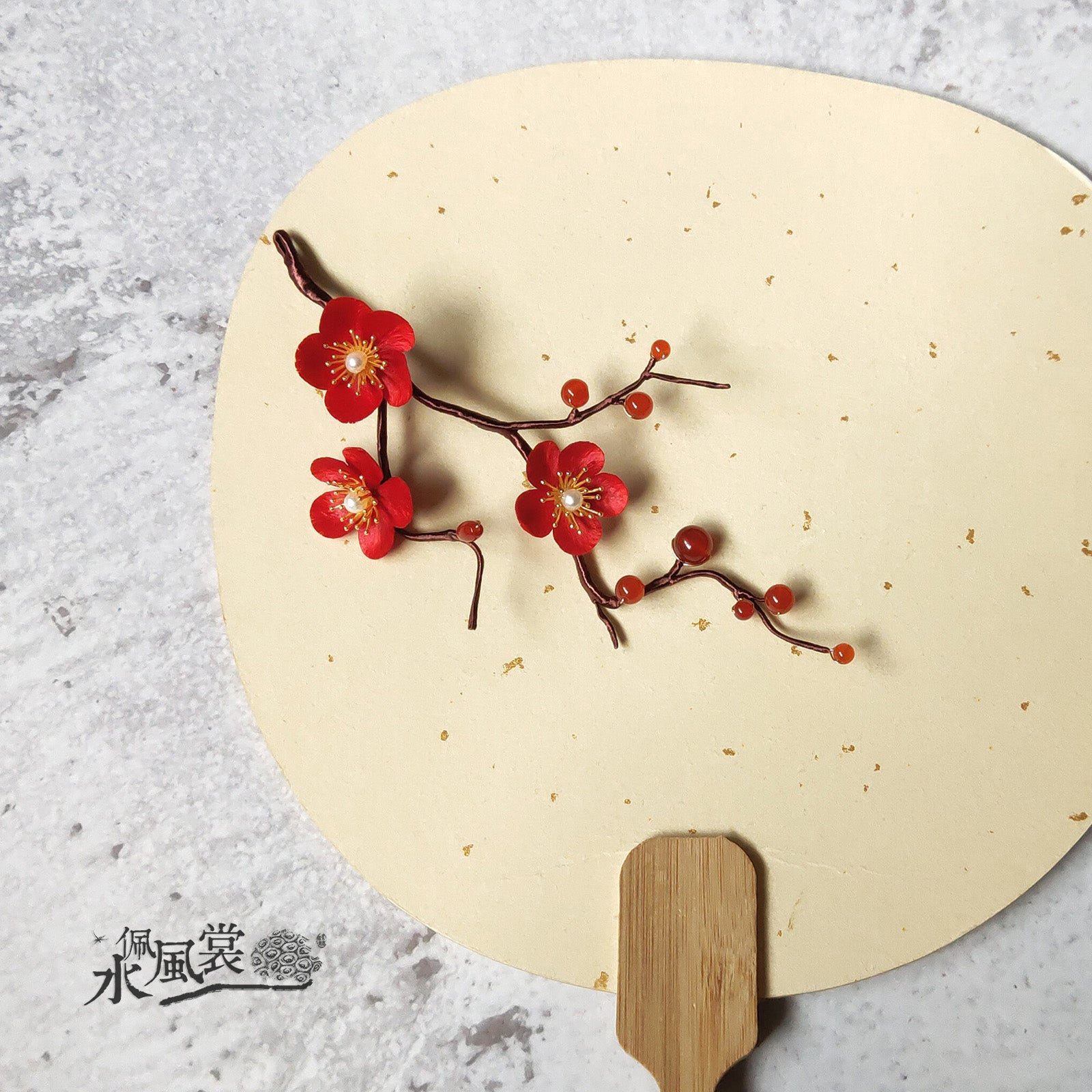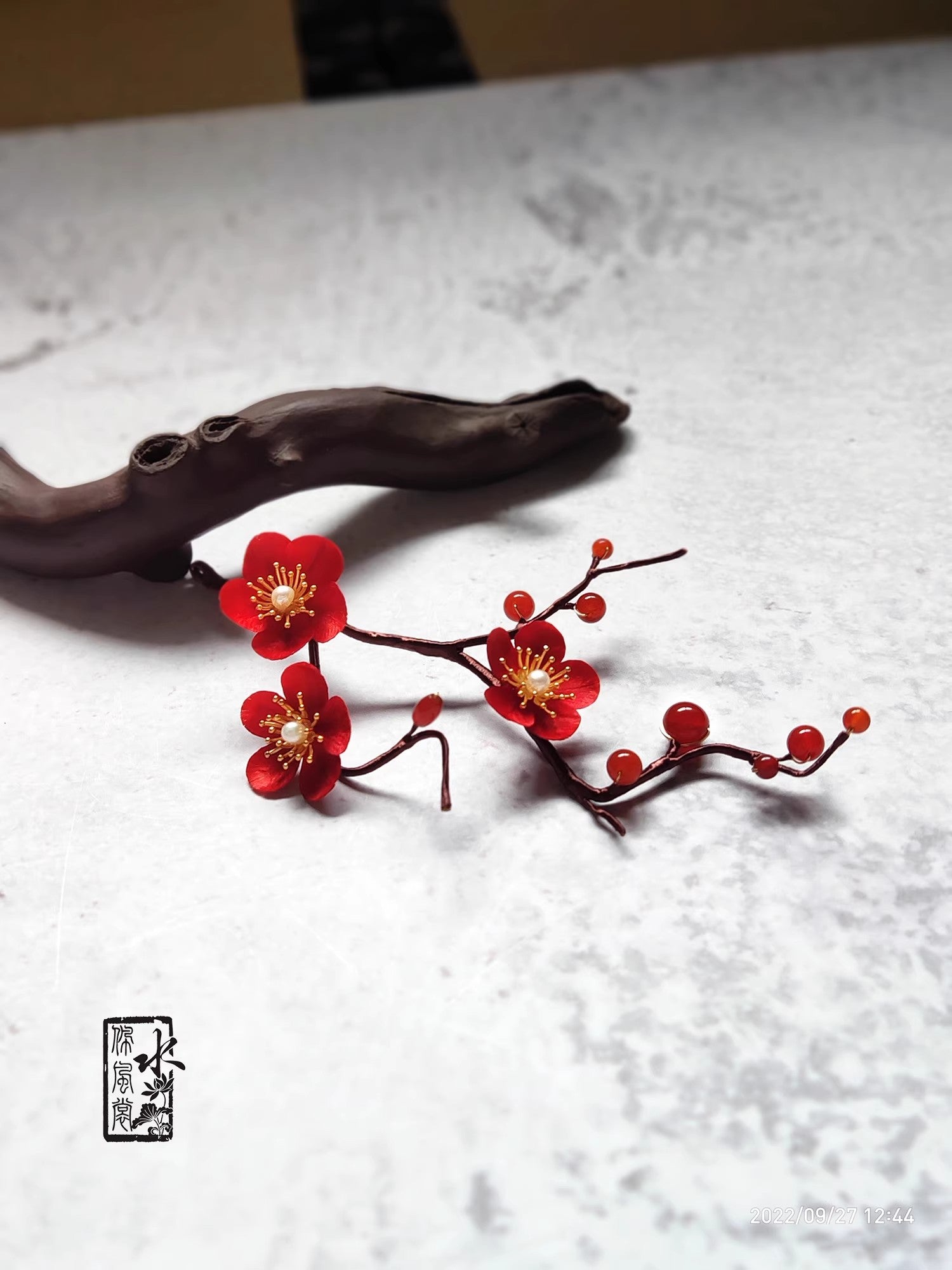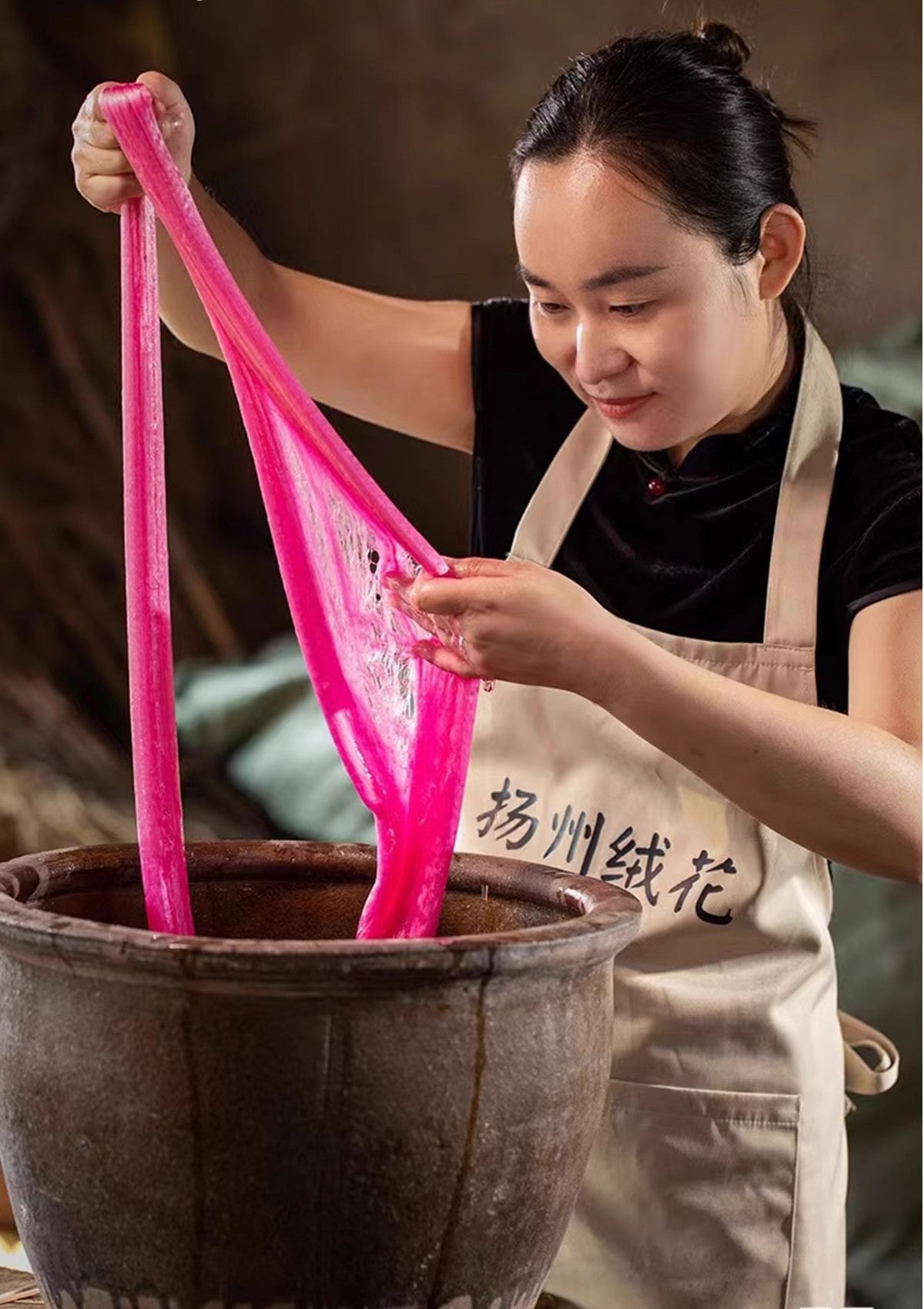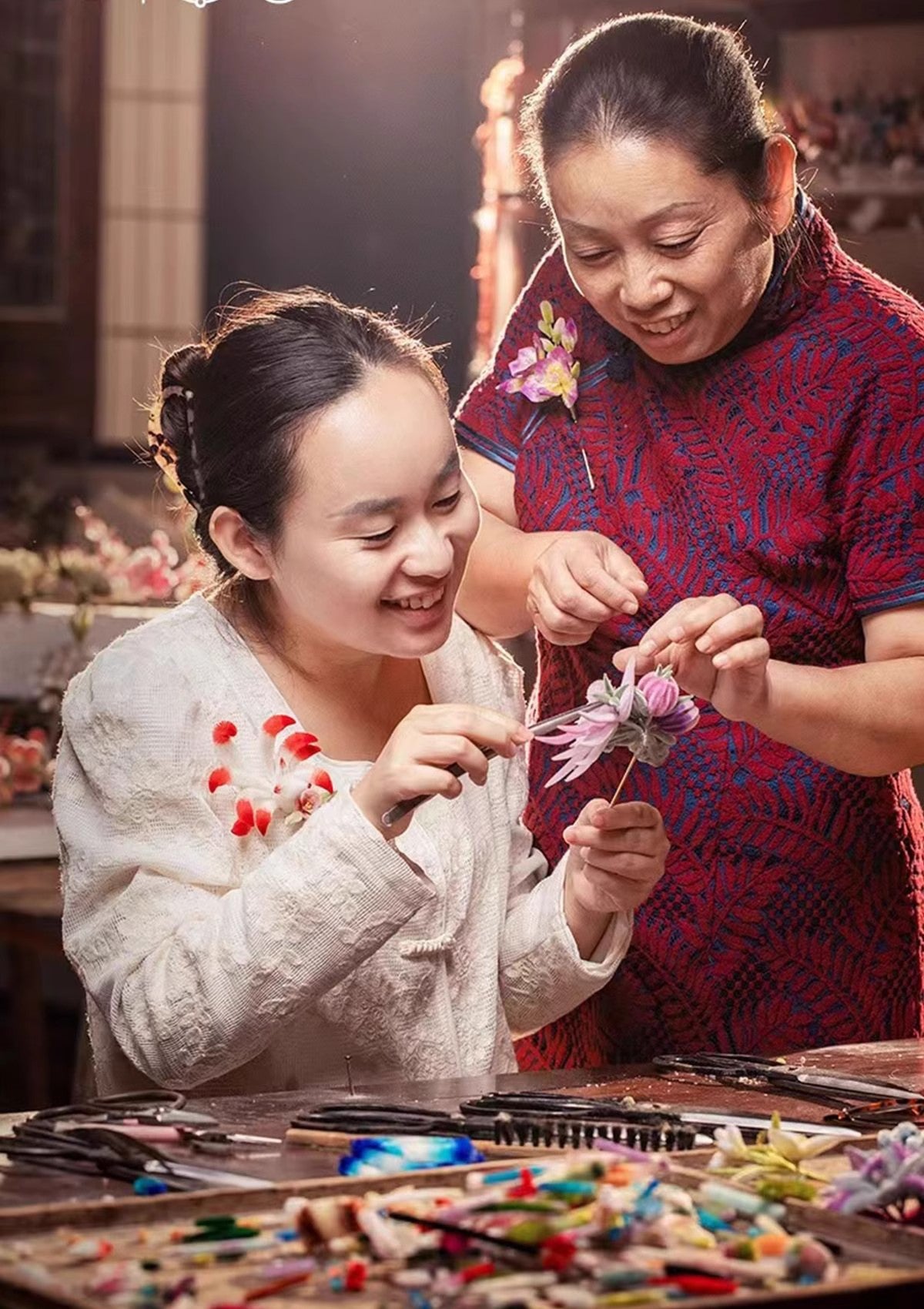






Chinese Silk Velvet Flower – Plum Blossom Hairpin
Why We Are Different
Mulberry Silk Materials
Lightweight and Lifelike
Traditional Handcraftsmanship
Authentic Chinese Heritage Art
Silk, wool, copper, natural agate, freshwater pearls
To ensure the longevity of velvet flowers, store them in a dry, shaded environment, avoiding direct sunlight and moisture, and gently clean with a soft brush to preserve their delicate craftsmanship and vibrant colors.
Estimate delivery time 6-10 days
May take 1-5 business days

Symbols of Prosperity and Elegance
Handcrafted Silk Velvet Flowers
Silk velvet flower accessories trace back to ancient China, where they were once symbols of elegance and status worn by nobility and brides. Each flower was painstakingly crafted by artisans who used fine mulberry silk to create lifelike petals, capturing the beauty of nature. This delicate art was nearly lost over time, as modern manufacturing replaced many handcraft traditions.
Today, we bring this legacy to life with carefully handcrafted hairpins and brooches, preserving the timeless allure of silk velvet flowers. Each piece is a tribute to Chinese heritage—a blend of grace, tradition, and artistry—bringing a piece of history into your collection.
Crafted with Skill and Care
Each piece is meticulously handmade by skilled artisans, making every flower unique and imbued with exceptional craftsmanship and quality.
Light, Elegant, and Versatile
Designed for both comfort and style, these delicate accessories are perfect for special occasions or everyday wear, adding a touch of elegance to any outfit.
Vibrant Colors, Made to Last
Made from premium materials, these accessories retain their vivid colors and beauty over time, providing a lasting symbol of joy and celebration.
Rich in Tradition and Meaning
Each design carries a meaningful cultural symbolism, representing good fortune, happiness, and prosperity—ideal as a thoughtful gift or a personal keepsake.
From Katrin
"The Journey to Reviving a Lost Art: A Story from MOMOTAR & Chinese Silk Velvet Flowers"

As the founder of MOMOTAR, my love for beautifully crafted, handmade items has always been at the core of what we do. Our luxurious silk sleepwear and lingerie are more than just garments—they’re a celebration of the artistry behind them. But my journey took an unexpected turn when I discovered the ancient art of Chinese silk velvet flowers (绒花), a craft nearly lost to time.
These delicate silk flowers, once worn by women to symbolize elegance and grace, are a precious part of China’s cultural heritage. However, as modern manufacturing methods took over, the intricate craft of making these velvet flowers began to fade. When I learned that the tradition had nearly vanished, I felt an undeniable pull to help revive it.
I knew this wouldn’t be an easy task, but I was determined. So, I packed my bags and traveled to Yangzhou, the birthplace of the craft, hoping to find the last remaining artisans who could teach me their secrets. What I thought might be a straightforward search quickly turned into a long and challenging journey. Days turned into weeks, and every door I knocked on seemed to bring the same answer: "It’s gone. No one does this anymore."
Just when I thought all hope was lost, I was told about a woman named Li Mei, whose family had been making silk velvet flowers for generations. Finding her wasn’t easy, but when I finally stood in her workshop, I knew I had discovered something special. Her hands moved with the skill of centuries of tradition, transforming simple silk threads into lifelike flowers that looked as though they had been plucked from a garden.
I was captivated, not just by the beauty of her work, but by the painstaking process behind it. Watching Li Mei work, I realized that each flower took hours, even days, to create. The process begins with selecting the finest silk or cotton threads, which are then dyed in rich, vibrant colors. These threads must be cut, twisted, and shaped into petals, leaves, and stems, with each component requiring precise attention to detail. It’s a craft where even the smallest mistake means starting over.
Li Mei was kind enough to let me try my hand at it. At first, I was excited—how hard could it be? But I quickly learned that this was no simple task. I struggled to twist the threads just right, and my attempts at shaping the petals were far from the elegant forms Li Mei crafted so effortlessly. Each time I thought I was making progress, the silk would unravel, or the petals would collapse.
I failed—over and over again.

There were countless times when I thought, "Maybe this isn’t something I can do." But that only deepened my respect for the artisans like Li Mei, who had spent their lives mastering this craft. For them, every flower is a labor of love, a piece of their heart woven into the silk.
It’s no exaggeration to say that creating a single velvet flower requires not just skill, but patience and dedication. The petals must be carefully cut and shaped, and each one is bound by hand, requiring the perfect balance of tension and precision. Once assembled, the flowers are polished and arranged into their final form, each petal lying in harmony with the others. The end result? A stunning, lifelike bloom that carries with it the soul of the artisan who made it.
Li Mei and I became friends through this process, bonding over our shared love for preserving traditional arts. Together, we decided to collaborate and bring these silk velvet flowers to the world. Every flower we offer at MOMOTAR is handcrafted by artisans like Li Mei, using techniques passed down through generations. Each one is a unique work of art, a living piece of heritage that has survived against the odds.
Now, alongside our luxurious silk sleepwear, these velvet flowers have found a home at MOMOTAR. They aren’t just accessories; they’re symbols of resilience, tradition, and the beauty that can only come from human hands. When you wear one of these flowers, you’re not just wearing a piece of jewelry—you’re carrying a piece of history, a craft that was almost lost but is now alive and thriving.
I never imagined that my journey would lead me to the revival of such a precious art form, but now, I’m more committed than ever to sharing this beauty with the world. It hasn’t been easy—there were countless obstacles along the way—but the end result has been more rewarding than I could have ever imagined.
And now, with every silk velvet flower we create, I invite you to join us in preserving this incredible tradition. Let’s celebrate the artistry, the history, and the hands that keep this beautiful craft alive.
As the founder of MOMOTAR, my love for beautifully crafted, handmade items has always been at the core of what we do. Our luxurious silk sleepwear and lingerie are more than just garments—they’re a celebration of the artistry behind them. But my journey took an unexpected turn when I discovered the ancient art of Chinese silk velvet flowers (绒花), a craft nearly lost to time.
These delicate silk flowers, once worn by women to symbolize elegance and grace, are a precious part of China’s cultural heritage. However, as modern manufacturing methods took over, the intricate craft of making these velvet flowers began to fade. When I learned that the tradition had nearly vanished, I felt an undeniable pull to help revive it.
I knew this wouldn’t be an easy task, but I was determined. So, I packed my bags and traveled to Yangzhou, the birthplace of the craft, hoping to find the last remaining artisans who could teach me their secrets. What I thought might be a straightforward search quickly turned into a long and challenging journey. Days turned into weeks, and every door I knocked on seemed to bring the same answer: "It’s gone. No one does this anymore."
Just when I thought all hope was lost, I was told about a woman named Li Mei, whose family had been making silk velvet flowers for generations. Finding her wasn’t easy, but when I finally stood in her workshop, I knew I had discovered something special. Her hands moved with the skill of centuries of tradition, transforming simple silk threads into lifelike flowers that looked as though they had been plucked from a garden.
I was captivated, not just by the beauty of her work, but by the painstaking process behind it. Watching Li Mei work, I realized that each flower took hours, even days, to create. The process begins with selecting the finest silk or cotton threads, which are then dyed in rich, vibrant colors. These threads must be cut, twisted, and shaped into petals, leaves, and stems, with each component requiring precise attention to detail. It’s a craft where even the smallest mistake means starting over.
Li Mei was kind enough to let me try my hand at it. At first, I was excited—how hard could it be? But I quickly learned that this was no simple task. I struggled to twist the threads just right, and my attempts at shaping the petals were far from the elegant forms Li Mei crafted so effortlessly. Each time I thought I was making progress, the silk would unravel, or the petals would collapse.
I failed—over and over again.
There were countless times when I thought, "Maybe this isn’t something I can do." But that only deepened my respect for the artisans like Li Mei, who had spent their lives mastering this craft. For them, every flower is a labor of love, a piece of their heart woven into the silk.
It’s no exaggeration to say that creating a single velvet flower requires not just skill, but patience and dedication. The petals must be carefully cut and shaped, and each one is bound by hand, requiring the perfect balance of tension and precision. Once assembled, the flowers are polished and arranged into their final form, each petal lying in harmony with the others. The end result? A stunning, lifelike bloom that carries with it the soul of the artisan who made it.
Li Mei and I became friends through this process, bonding over our shared love for preserving traditional arts. Together, we decided to collaborate and bring these silk velvet flowers to the world. Every flower we offer at MOMOTAR is handcrafted by artisans like Li Mei, using techniques passed down through generations. Each one is a unique work of art, a living piece of heritage that has survived against the odds.
Now, alongside our luxurious silk sleepwear, these velvet flowers have found a home at MOMOTAR. They aren’t just accessories; they’re symbols of resilience, tradition, and the beauty that can only come from human hands. When you wear one of these flowers, you’re not just wearing a piece of jewelry—you’re carrying a piece of history, a craft that was almost lost but is now alive and thriving.
I never imagined that my journey would lead me to the revival of such a precious art form, but now, I’m more committed than ever to sharing this beauty with the world. It hasn’t been easy—there were countless obstacles along the way—but the end result has been more rewarding than I could have ever imagined.
And now, with every silk velvet flower we create, I invite you to join us in preserving this incredible tradition. Let’s celebrate the artistry, the history, and the hands that keep this beautiful craft alive.



* MOMOTAR Silk is meticulously crafted to meet our exacting standards, reflecting over a decade of development and refinement. Our focus is on delivering the perfect blend of luster and thickness. We use the finest grade (6A) long-fiber mulberry silk, available in 19 or 22 momme weight, and strictly adhere to high-quality standards, including the use of non-toxic dyes. As a dedicated brand specializing in silk sleepwear, we prioritize excellence in every aspect of our product.
Frequently asked questions
What is the biggest difference between cotton and silk?
While most people opt for cotton sleepwear, silk pajamas offer a refreshing alternative. Silk is incredibly comfortable, thanks to its protein structure that closely resembles our skin, helping to maintain skin hydration. Research has shown that silk possesses antimicrobial properties, inhibiting bacterial growth. With its smooth surface and seamless fiber structure, silk is less likely to collect dust mites and bacteria, making it an excellent choice, especially for those prone to allergies.
What is the difference between silk and satin?
Satin is a particular weaving technique and often made of polyester. This is synthetic material. Which results in a tingly and static feeling and is not as cooling and soft as silk. This may seem familiar to you! Experience the difference with the highest quality mulberry silk today.
Is it suitable for every skin type?
Sure! Unlike other skin care products, our products are suitable for all skin types.
Is silk suitable for everyone?
Yes, whether for women, men, children, or the elderly, silk is the best choice.







